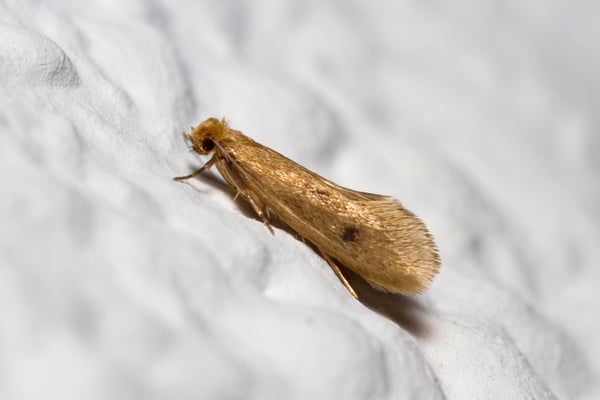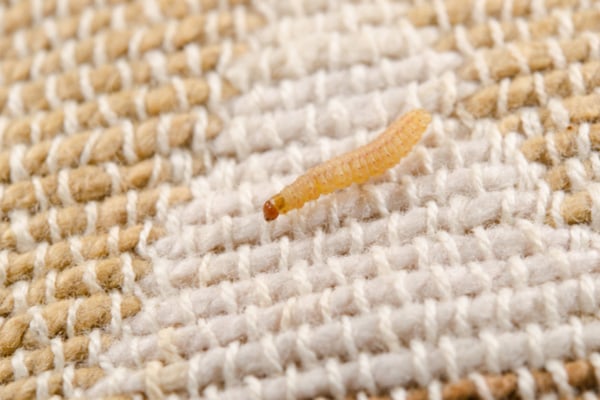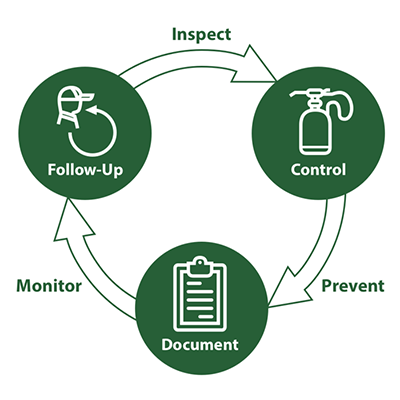Casemaking Clothes Moth
Appearance And Behavior
Though it’s less common than most pantry pest moths, the casemaking clothes moth (Tinea pellionella) is still a notable pest in US homes. The name “casemaking” refers to the silken cocoon or “case” the moth larvae tend to spin for themselves. These moths live all over the world, but they’re particularly common in the southern US.
Casemaking clothes moths measure about 3/8 to 1/2" long from wing tip to wing tip. Both their forewings and hind wings are long and narrow, with 3 dark spots on each front wing. Front wings are fringed with long, fine hairs. The rest of the adult moth’s bodies and wings are golden with a brownish tinge.
Mature casemaking clothes moth larva are ⅜” long and clear white, except for their brown heads and first thoracic segments.
Casemaking clothes moth larvae primarily feed on materials made from animal bi-products. They frequently infest and feed on feathers, wool, rugs, fur, felt, leather, animal remains, and other fabrics. If they can’t access these primary food sources, they may resort to feeding on plant material such as tobacco, herbs and seasoning, or other dry goods. They’re particularly attracted to feathers/down, animal hair, and fur.
Life Cycle

Like other moths, casemaking clothing moths undergo complete metamorphosis, hatching from eggs and undergoing larval, pupae, and adult stages. This complete cycle can take anywhere between three weeks to three or more years depending on the moth’s environment.
Female moths lay eggs in small clusters on food sources such as fabric or fur. These eggs typically hatch into larvae within 4 to 10 days, though it’ll take longer in cold environments. Casemaking clothing moths spend the majority of their lives in the larval stage. During this stage, they feed on nearby food sources continuously while growing and molting. When they’ve eaten enough, larvae pupate within their silk cases. Upon emerging, adult moths can’t eat. They only live long enough to reproduce and lay eggs so the cycle can begin again.
Casemaking Clothes Moth Prevention

Dry clean and/or launder wool, felt, fur, and leather garments regularly. Store your clothing in airtight garment storage bags or boxes when you’re not actively using it. Consider placing clothing you wear infrequently in refrigerated storage. Clean wool furniture, blankets, carpeting, and rugs professional as regularly as possible, especially if it sees heavy use. Consider treating these items with insecticidal protectants such as borate or permethrin, too.
Vacuum pet hair and fur off of floors and furniture at least once a week. Check your pet’s bedding or favorite spots for signs of infestation. Wash your pet’s bedding frequently, especially if it gets dirty quickly. Store any other plant or animal materials that are susceptible to moth attack in protective containers or displays.
Casemaking Clothes Moth Control Process
The key to control is thorough inspection, proper identification, regular sanitation, and (when it’s necessary) appropriate pesticide application. A Plunkett’s technician starts our treatment by searching your entire premises for sources of infestation.
We’ll identify all infested items for cleaning and, where available, treat them with a insecticide protectant. We may also perform spot treatments within closets and other infested rooms using aerosol or liquid insecticide. The technician may perform spot treatments within closets and other infested rooms using an aerosol or liquid insecticide.
If you think you have a casemaking moth infestation, give Plunkett’s a call right away. We’ll keep your closets and clothing safe.

Moth Control With Plunkett's
At Plunkett’s, our goal is to help you quickly, conveniently, and in the most cost-effective way. We make every effort to be with you asap, usually within a day or two.
Learn More
There are a good number of stored product pests that are particularly likely to make pests of themselves around your home. Some of the most common examples of stored product pests Plunkett’s encounters frequently include:






